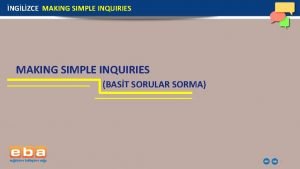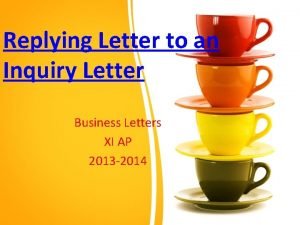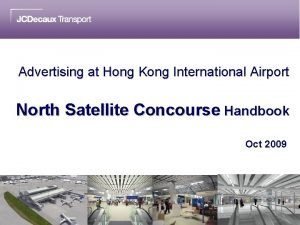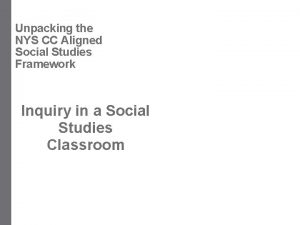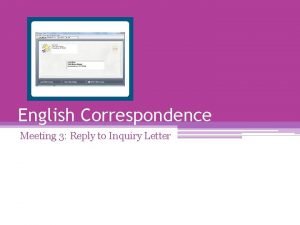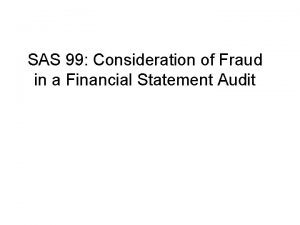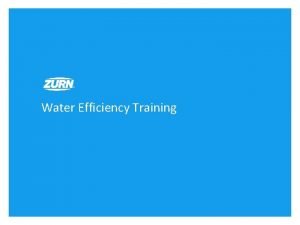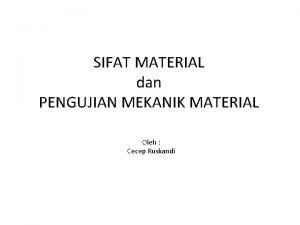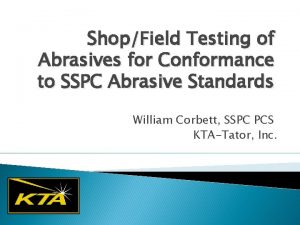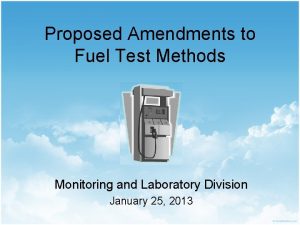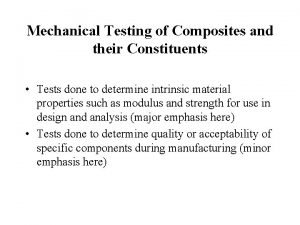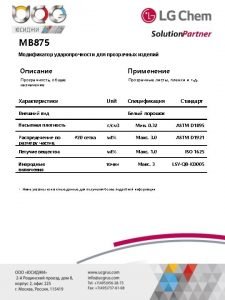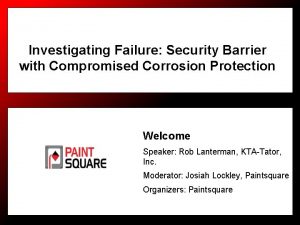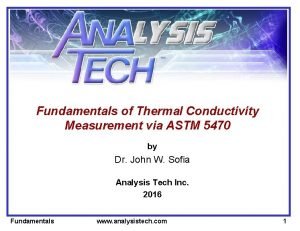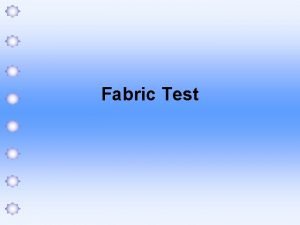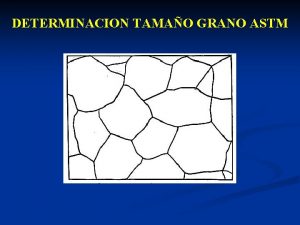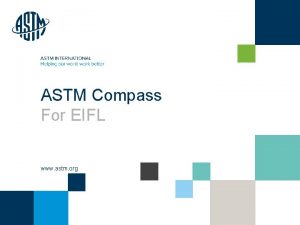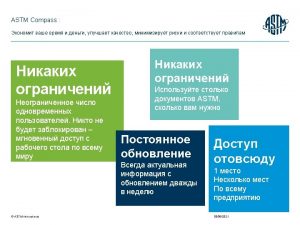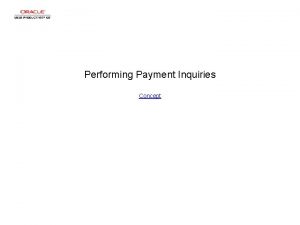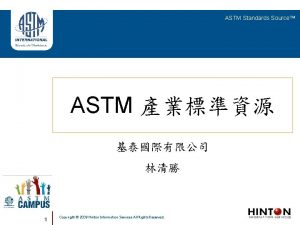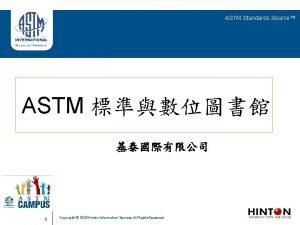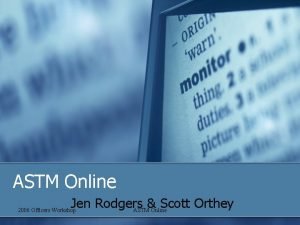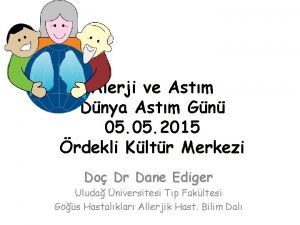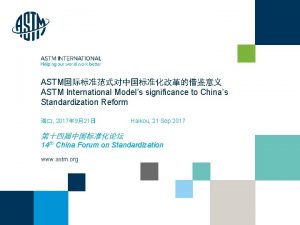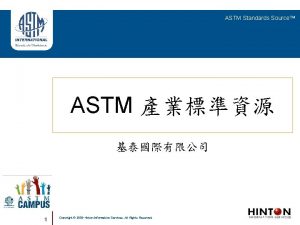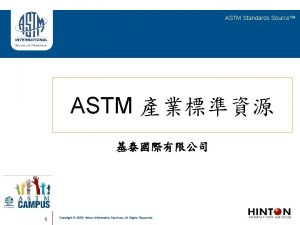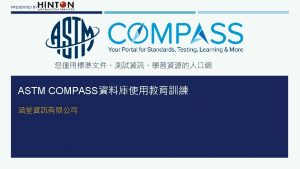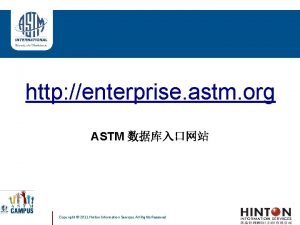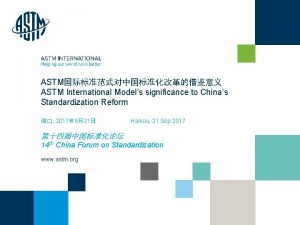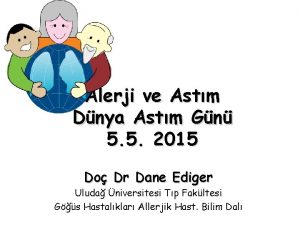New ASTM Standard and All Appropriate Inquiries Austin


























- Slides: 26

New ASTM Standard and “All Appropriate Inquiries” Austin Bar Assn. Environmental Law Section February 6, 2014 Steve Dickman Kelly Hart & Hallman LLP Email: stephen. dickman@kellyhart. com

Historical Background �CERCLA Strict Liability: owners – operators – generators – transporters �CERCLA Third Party Defense: unavailable if contractual relationship � 1986 Superfund Reauthorization: Innocent Landowner Defense if AAI made � 2002 Brownfield Amendments LLPs: Contiguous Owner; Bona Fide Prospective Purchaser �BFPP: Acquisitions after Jan. 11, 2002. Pre-acquisition knowledge of contamination OK

Qualifying for BFPP and Other LLPs Pre-Acquisition Requirements: �Disposal occurred prior to property acquisition �Landowner not related to a PRP �Landowner conducts AAI

Qualifying for LLPs Post-Acquisition Requirements: �Provide required notices �Reasonable steps to stop/prevent a release �Full cooperation with agencies and responders �Comply with land use restrictions �Comply with CERCLA RFIs

“All Appropriate Inquiries” Definition of “contractual relationship”. 42 U. S. C. § 9601(35)(B) To show “no reason to know” landowner must show (s)he “carried out all appropriate inquiries… into the previous ownership and uses of the facility in accordance with generally accepted good commercial and customary standards and practices. ” AAI must be conducted within one year prior to acquisition.

Historical Background Nov. 1, 2005: EPA Final Rule on AAI (40 CFR Part 312) eff. Nov. 1, 2006 (allowed use of ASTM E 1527 -05). Aug. 15, 2013: EPA Direct Final Rule and Companion Rule (allowed use of ASTM E 1527 -13 or E 1527 -05). Aug. – Oct. 2013: EPA received adverse comments (opposition to having two differing ASTM standards) Oct. 29, 2013: EPA withdrew Direct Final Rule Dec. 30, 2013: EPA Final Rule Amending Part 312 to permit use of ASTM E 1527 -13; no retraction of allowance to use ASTM E 1527 -05, but rule to do so is forthcoming

ASTM Standard E 1527 American Society For Testing and Materials (ASTM): May be used on voluntary basis to define good commercial and customary practice for Phase 1 ESA of commercial real estate for CERCLA hazardous substances and petroleum products. Purpose is to satisfy AAI as one of the required elements for LLPs. Goal is to identify “Recognized Environmental Conditions” (RECs).

ASTM Standard E 1527 Four Components of Phase I ESA: �Records Review (Sec. 8) – Database info; Agency files; Facility records �Site Reconnaissance (Sec. 9) – Personal site visit by EP �Interviews (Sec. 10) – with past/present owners/occupants; with government officials �Evaluation and Report (Sec. 12) – findings; opinion; additional investigation; data gaps; conclusions.

ASTM Standard E 1527 �Must be performed by Environmental Professional (EP). Qualifications in § 312. 10(b). May be employee or indep. contractor of User. �Specifies User Responsibilities. (Sec. 6) �No sampling required. (Sampling work is Phase II ESA. ) �No evaluation of “Business Environmental Risk” (nonscope issues such as mold; asbestos; lead; radon; wetlands; endangered species; compliance with AULs; regulatory compliance). (Sec. 13)

Relationship Between 40 CFR Part 312 and ASTM E 1527 �ASTM 1527 E (05 and 13) are not federal regulations. �All Phase I ESAs must comply with Part 312 and must so state. �EPA determined that compliance with ASTM E 1527 = compliance with § 312. 23 thru 312. 31. �No requirement to use or comply with ASTM E 1527.

Principal Changes in ASTM E 1527 -13 from E 1527 -05 �Revised definition of “Recognized Environmental Condition” �Revised definition of “Release” �Revised definition of “Environment” �Clarified definition of “Historical REC” (HREC) �New definition for “Controlled REC” (CREC) �Clarification of definition of “De Minimis Condition”

Principal Changes in ASTM E 1527 -13 from E 1527 -05 �Revised definition of “Migrate / Migration” to include vapor migration �Additional guidance on Regulatory Agency File and Records Review �Revised scope of “User Responsibilities” �New flexibility re: wording of Conclusion Statement �Updated info in non-binding Appendices

Revised Definition of “Recognized Environmental Condition” “The presence or likely presence of any hazardous substances or petroleum products in, or at a property: (1) due to a release to the environment; (2) under conditions indicative of a release to the environment; or (3) under conditions that pose a material threat of a future release to the environment. De Minimis conditions are not recognized environmental conditions. ” �streamlined from definition in ASTM E 1527 -05 �more consistent with § 312. 20(e) statement of objectives of AAI Rule. �Part 312 does not use term “REC”; instead, “conditions indicative of a release or threatened release”.

Revised Definitions of “Release” and “Environment” Definitions now conform to definitions of “Release” and “Environment” in CERCLA. Removes confusion caused by different definitions of these terms.

Clarified Definition of “Historical REC” (HREC) “A past release of any hazardous substances or petroleum products that has occurred in connection with the property and has been addressed to the satisfaction of the applicable regulatory authority or meeting unrestricted use criteria established by a regulatory authority, without subjecting the property to any required controls” (e. g. , property use restrictions, activity and use limitations, institutional controls, engineering controls). �HREC only applies to past release remediated to unrestricted use (residential) criteria. �Remediation of past release cannot be achieved thru using environmental controls. �If remediated past release would not qualify under current rules for unrestricted use, it is a REC; otherwise, it does not need to be identified as a REC.

New Definition of “Controlled REC” (CREC) �Past release remediated to agency satisfaction using environmental controls (e. g. , property use restrictions, activity and use limitations, institutional controls, engineering controls) for contamination remaining in place. �CREC must be identified as a REC in Conclusions section of Phase I report. No longer proper to classify these cases as HRECs as done in many Phase I ESAs. �Does not require EP to evaluate adequacy or effectiveness of control(s).

Clarification of Definition of “De Minimis Condition” “A condition that generally does not present a threat to human health or the environment and that generally would not be the subject of an enforcement action if brought to the attention of the appropriate governmental agencies. Conditions determined to be de minimis conditions are not [RECs] nor [CRECs]. ” �De Minimis conditions would not be subject to an agency enforcement action. �De Minimis conditions cannot be a REC or CREC. No longer proper to classify CRECs as a De Minimis condition as done in many Phase I ESAs.

Revised Definition of “Migrate/Migration” to Include Vapor Migration “Migrate/Migration refers to the movement of hazardous substances or petroleum products in any form, including, for example, solid or liquid at the surface or subsurface, and vapor in the subsurface. ” �Under ASTM E 1527 -05 vapor migration were typically excluded from Phase I ESA scope as an indoor air quality issue. �Now, vapor intrusion must be evaluated if VOC contamination of groundwater or soil exists on subject property or nearby property. �Indoor air quality issues unrelated to releases of hazardous substances or petroleum products are still non-scope issues.

Evaluation of Vapor Migration �Complexity: Vapor migration does not necessarily follow the same pathways as groundwater plumes, but rather utility corridors. �Inadequate available information to assess risk of migration from neighboring properties. �Inability to evaluate vapor migration risk may result in EP defaulting to classification as REC. �ASTM E 1527 -13 does not require use of vapor screening in Phase I ESAs, but if classified as a REC the EP may recommend it to address the REC. See ASTM E 2600 -10 for vapor encroachment screening standard practices. �HRECs closed without evaluating potential for vapor migration may become RECs.

Evaluation of Vapor Migration �In Dec. 30, 2013 AAI Rule, EPA stated that it has always considered vapor migration to be an appropriate element of a Phase I ESA. 78 Fed. Reg. 79322 �Question: Can EPA’s statement be used to support a claim of no LLP for vapor migration problem sites that were the subject of Phase I ESA that did not consider vapor migration? �Question: Can EPA’s statement be used to support a claim that an EP is liable for failure to evaluate vapor migration risk?

Guidance on Regulatory Agency File and Records Review EP should review regulatory agency files re: standard database listings (e. g. , Geo. Search listings of CERCLIS, RCRIS or LPST sites) for subject site and adjoining sites. EP may review alternative sources (e. g. , on-site records; interviews with regulatory officials) if sufficient to determine presence of RECs without reviewing agency records. EP must evaluate sufficiency of info reviewed and justify any decision not to review agency file records. EP must plan for added time and cost of obtaining and reviewing agency files (“reasonably available” still means within 20 days of request).

Revised Scope of User Responsibilities ASTM E 1527 -13 clarifies that User is responsible for: �conducting a review of property records (and judicial records) for environmental liens and AULs; �User’s specialized knowledge and commonly known info re: existence of RECs; �Reasons for any below-market purchase price. For any failure of User to provide such info, EP must note it in Phase I Report and opine on significance of not having the info.

Wording of Conclusion Statement �Two possible Conclusion Statements: one where no RECs identified; one where RECs are identified. �No Conclusion Statement wording changes in ASTM E 1527 -13. �ASTM E 1527 -13 now allows for wording substantially similar to the wording in Section 12. 8. �EP Recommendations for further action not required.

Updated Info in Non-Mandatory Appendices Appendix X 1 – CERCLA and AAI legal background with caselaw and statutory citations Appendix X 2 – Definition of “Environmental Professional” and relevant experience Appendix X 3 – User Questionnaire Appendix X 4 – Recommended Table of Contents and Report Format Appendix X 5 – Summary of common non-scope issues

Probable Consequences of Revised ASTM E 1527 -13 �Increased cost of conducting AAI – EP’s review of vapor intrusion pathway, agency records, and current compliance status of HRECs will all increase cost of doing Phase I ESAs. �Increased time of conducting AAI – Obtaining and reviewing agency file records, and adding justifications for EP’s failures to follow ASTM E 1527 -13, requires more time. �Increase in number of RECs to be resolved thru supplemental investigation – due to vapor migration issues discovered, HRECs currently non-compliant, CRECs. �Additional RECs could lead to more demands for financial holdbacks, escrow funds, indemnities, insurance coverage, or sales price concessions.

Practical Impacts of Revised ASTM E 1527 -13 �Revise consultant master agreements to require compliance with ASTM E 1527 -13. �Review new Phase I ESAs for compliance with ASTM E 1527 -13. �Negotiate longer due diligence period in transaction documents. �Expect higher consultant fees for Phase I ESAs. �Need for more experienced and qualified Phase I ESA consultants.
 Inquiry answer 124
Inquiry answer 124 Spt hammer types
Spt hammer types Simple inquiries
Simple inquiries Reply enquiry letter
Reply enquiry letter For inquiries please contact
For inquiries please contact Iowa social studies standards unpacked
Iowa social studies standards unpacked For inquiries, please contact sample
For inquiries, please contact sample For inquiries, please contact sample
For inquiries, please contact sample Sas 99 inquiries
Sas 99 inquiries Manor new tech high school
Manor new tech high school Name
Name Standard error and standard deviation
Standard error and standard deviation Home language and standard language
Home language and standard language Standard cost is predetermined cost
Standard cost is predetermined cost Zurn
Zurn Deformasi
Deformasi Standar spesimen uji tarik astm e8
Standar spesimen uji tarik astm e8 Sspc-ab1
Sspc-ab1 Astm d7754
Astm d7754 Rock solid septic
Rock solid septic Astm d 7078
Astm d 7078 Astm d1921
Astm d1921 Tanah glacial
Tanah glacial X-cut astm d6677
X-cut astm d6677 Example
Example Astm d 434
Astm d 434 Tamaño de grano astm tabla
Tamaño de grano astm tabla


